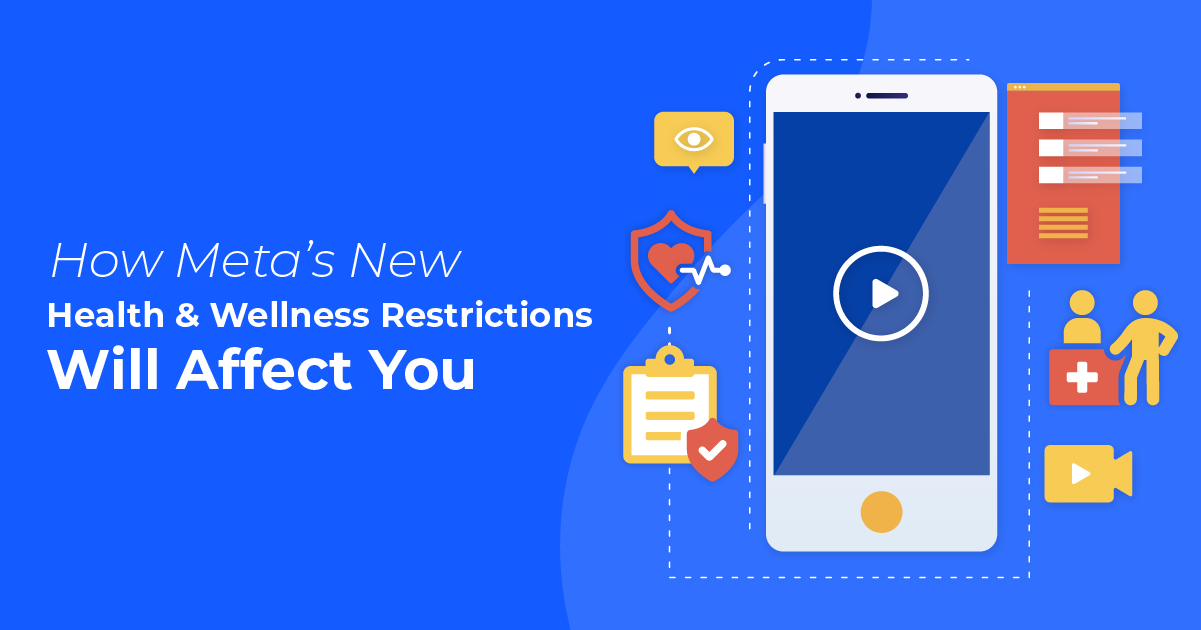How Meta’s New Health & Wellness Advertising Restrictions Will Affect You
Everyone in the digital advertising world knows that Meta has been able to sneak in new, unwanted restrictions and AI optimizations slowly throughout the past few years.
From automatically opting you into AI written captions, music, and placements, to now restricting what data you can track on health & wellness accounts and campaigns.
Meta has built a reputation for making changes faster than advertisers can even adjust to them… but have no fear! After reading this blog, you’ll be prepared for the health & wellness changes that are taking place within your accounts.
______________________________________________________________________________
Why These Restrictions Matter to Health & Wellness Advertisers
Whether you’re running ads for your health & wellness brand, or one of your clients, you’ll start to notice a loss in data, conversion tracking limitations, and shrinking audience sizes. Let’s break down the key changes and how they impact your Meta ad accounts.
1. Loss of Bottom-Funnel Standard & Custom Event Tracking
Tracking micro-conversions and standard events is essential for optimizing ad performance. At AdShark, we always recommend tracking as many touchpoints throughout the funnel as possible. However, you may notice restrictions on what Meta considers “low-funnel standard events”.
What’s classified as ‘low funnel’ anyway? Meta’s latest restrictions prevent brands in certain industries from reporting on or optimizing for bottom-funnel events, including:
- Purchases
- Leads
- Contracts
- Registrations
- Any clicks on a “buy now” button on a product page
Luckily, not all standard events were affected (phew!) High funnel events like Add to Cart, Donation, and View Content are still up for grabs.
Workarounds:
Some ways you can combat these changes:
- Optimize for Higher-Funnel Conversions: Instead of tracking purchases or leads, consider optimizing for users who have initiated checkout or added an item to their cart.
- Use Google Tag Manager (GTM) for Event Labeling: If an event like “Lead” is blocked in your Meta ad account, you can use GTM to send the same conversion as a different standard event that Meta still allows (like Donation, or Customize Product). In a nutshell, you’d be reporting a contact form submission as a donation, and Meta wouldn’t even recognize the difference!
2. Custom Audiences May Shrink (or Stop Updating)
Meta now restricts the use of custom parameters and data in URLs for audience building.
This will affect…
- Retargeting audiences that rely on URLs or custom parameters
- Lookalike audiences built from custom audiences
So remember, if your retargeting or lookalike audiences suddenly stop updating or shrink drastically, this is why.
Workarounds:
There are ways to dodge some of these restrictions:
- Use first-party data: Now’s the time to build and nurture those email lists, SMS subscribers, and loyalty programs to create owned audience segments.
- Experiment with broader audience strategies: Test interest-based targeting or broad audience campaigns to reach new users.
3. Advanced Matching & Meta Pixel Catalog Updates Will Break
Meta now restricts how advanced matching works for Health & Wellness accounts. This will impact:
- Automatic advanced matching: you may need to manually configure advanced matching instead.
- Meta Pixel catalog updates: if your store syncs products via Meta Pixel, you may have to upload them manually.
If your ads depend on dynamic product ads, abandoned cart recover, or CRM-based targeting, these changes could disrupt your ad performance.
4. Additional Tracking Restrictions in Certain Regions
Certain regions may experience even stricter tracking limitations due to compliance with local laws and regulations. If your business or clients operate in these regions, you may see:
- Loss of conversion tracking in specific countries
- More aggressive audience size reductions
- Additional compliance reviews or account warnings
My best advice? If your business operates internationally, monitor performance for regional discrepancies and adjust your ads accordingly.
How to Adapt to These Meta Ad Restrictions
Yeah, that was a lot. But don’t throw in the towel just yet! There are still ways to adjust your current strategy and maintain strong ad performance with these loopholes:
-
- Rely more on your first-party data: Start building direct customer relationships through email, SMS, and loyalty programs.
- Use manual advanced matching: If automatic options are blocked, set up manual event tracking to pass hashed customer data.
- Optimize for higher funnel conversions: We recommend optimizing for higher funnel conversions – this way you can still track them.
- Lean on Google Tag Manager: You can still use Google Tag Manager to send the same conversion as a different standard event that Meta still allows.
- Experiment with broader audience strategies: Instead of relying on retargeting, test interest-based targeting or broad audience campaigns.
- Expand on your ad platforms: Don’t put all your eggs in the Meta basket. Now might be the perfect time to try out some new ad platforms! Test Google, TikTok, and email marketing to fill in the Meta-shaped gap in your heart.
Final Thoughts
Meta’s latest health & wellness ad restrictions are just another way to reduce your advertiser control while increasing their own. These changes will limit visibility, weaken targeting, and may increase your ad costs.
If you’re running health & wellness ads, now is the perfect time to audit your tracking setup, explore alternative data sources, and switch up your strategy to stay ahead.
Need help navigating Meta’s ad changes, or are sick of trying to run ads yourself? We’d love to chat with ya! Connect with our team today to kickstart your digital marketing!
Written by Brier Gurholt
Ready To Grow?
Let's Talk!


